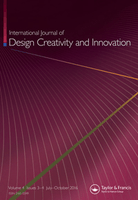
International Journal of Design Creativity and Innovation
Scope & Guideline
Bridging Disciplines to Inspire Creative Excellence
Introduction
Aims and Scopes
- Interdisciplinary Design Research:
The journal focuses on research that integrates insights and methodologies from various fields, including engineering, psychology, and business, to foster innovation in design. - User-Centered Design Approaches:
A significant emphasis is placed on user-centered methodologies in design processes, ensuring that the needs and experiences of end-users are central to innovation efforts. - Sustainability in Design:
The journal highlights the importance of sustainability, exploring how design practices can contribute to sustainable development and circular economy principles. - Technological Integration in Design:
Research on the impact of emerging technologies, such as AI, VR, and generative design tools, on the design process and creativity is a core focus area. - Creativity Assessment and Management:
The journal investigates various frameworks and tools for assessing and managing creativity within design contexts, aiming to improve creative outcomes in practice. - Cultural and Social Contexts of Design:
Exploration of how cultural, social, and environmental factors influence design creativity and innovation is a recurring theme in the journal.
Trending and Emerging
- Impact of AI on Design Creativity:
Recent studies are emphasizing the role of AI and machine learning in enhancing human creativity and ideation processes, reflecting the growing integration of technology in design. - Collaborative and Co-Design Practices:
There is a rising trend in research exploring collaborative design methodologies, particularly in community-based projects and interdisciplinary teams, showcasing the importance of collective creativity. - Sustainability and Circular Design:
Research focusing on sustainability-oriented design practices, including circular economy principles, is gaining traction, highlighting the need for environmentally responsible innovation. - Psychological and Emotional Factors in Design:
Emerging studies are increasingly examining the psychological aspects of creativity and the influence of emotional states on design outcomes, shedding light on the human factors in design processes. - Generative Design Tools and Techniques:
The application of generative design tools is becoming a prominent theme, with research exploring how these technologies can foster creativity and innovation in product design.
Declining or Waning
- Traditional Design Methods:
There is a noticeable decline in publications focusing solely on traditional design methodologies, such as manual sketching or basic CAD processes, as newer technologies and approaches gain traction. - Static Design Processes:
Research that emphasizes static or linear design processes is becoming less prevalent, with more emphasis on dynamic and iterative methodologies that incorporate feedback and adaptability. - Narrowly Focused Case Studies:
While case studies remain important, there is a shift away from narrowly focused case studies that do not integrate broader theoretical frameworks or interdisciplinary insights. - Design Education in Isolation:
Topics addressing design education without a connection to industry practices or real-world applications are appearing less frequently, indicating a preference for more integrative approaches. - Historical Perspectives on Design:
Explorations of historical design practices or retrospective analyses are declining, as the journal pivots towards more contemporary and forward-thinking design challenges.
Similar Journals

Design Journal
Connecting Ideas Across Arts, Humanities, and TechnologyDesign Journal, published by Routledge Journals, Taylor & Francis Ltd, serves as a pivotal platform for interdisciplinary research within the expansive fields of Arts and Humanities as well as Computer Graphics and Computer-Aided Design. With an ISSN of 1460-6925 and an E-ISSN of 1756-3062, this journal is dedicated to disseminating innovative ideas and methodologies that shape contemporary design practices. Ranked in the Q2 category in Arts and Humanities and Q3 in Computer Graphics per the 2023 category quartiles, it stands as a reference point for scholars and practitioners alike, fostering a vibrant community for sharing knowledge and fostering creativity. Researchers will find the journal's scope particularly valuable as it covers a diverse range of topics, providing insights critical for advancing knowledge and practice. With the journal continuing to evolve—converging research avenues from 2005 to 2024—it thrives as a beacon of scholarly excellence in the United Kingdom and beyond, appealing to professionals, researchers, and students eager to engage with cutting-edge design discourse.
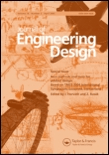
JOURNAL OF ENGINEERING DESIGN
Innovating Tomorrow's Engineering Design TodayJournal of Engineering Design, published by Taylor & Francis Ltd, is a prestigious platform for the dissemination of innovative research and developments in the field of engineering design. With an ISSN of 0954-4828 and an E-ISSN of 1466-1837, this journal has established itself as a vital resource for academics and practitioners alike since its inception in 1984. As a member of the Q2 category in the Engineering (miscellaneous) field for 2023 and ranking 71 out of 307 in general engineering on Scopus, the journal showcases cutting-edge research that pushes the boundaries of design methodology, tools, and applications across various engineering disciplines. Although it is not an open-access publication, its rigorous peer-review process ensures the highest quality of research. The journal's broad scope encompasses topics from product design and materials science to systems engineering and design thinking, making it an essential reading for those keen on the latest trends and advancements in engineering design. Published in the United Kingdom, the journal remains dedicated to nurturing a robust academic community, facilitating scholarly exchange, and providing valuable insights for researchers, professionals, and students engaged in engineering design.

Management and Production Engineering Review
Unleashing Potential through Peer-Reviewed ExcellenceManagement and Production Engineering Review, published by the Polish Academy of Sciences, stands as a pivotal platform for disseminating research in the realms of management, production engineering, and related fields. This journal operates under a commitment to providing high-quality, peer-reviewed articles that explore a range of impactful topics including business management, industrial engineering, and technology innovation. With a steady convergence period from 2012 to 2013 and continuing until 2024, it has earned a commendable position in the academic landscape, achieving a Q3 ranking across several critical categories like Business and International Management, Organizational Behavior, and Management Science. Its Scopus rankings reflect its emerging influence, particularly in the Industrial and Manufacturing Engineering sector, where it holds a rank of #173 out of 384. Although it does not offer an Open Access option, the journal remains a vital resource for academics and professionals seeking to expand their understanding and contributions to contemporary practices in management and production engineering.
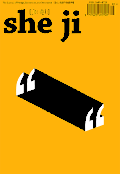
She Ji-The Journal of Design Economics and Innovation
Innovating Tomorrow through Design and Economic InsightShe Ji - The Journal of Design Economics and Innovation is a pioneering Open Access journal published by Elsevier since 2015, based in the Netherlands. With its unique focus on the intersection of design, economics, and innovation, this journal serves as a vital platform for researchers, professionals, and students who are keen on understanding the complexities of designing value-creating innovations. Consistently recognized for its high impact, She Ji holds a prestigious Q1 quartile ranking in both Economics and Education, while maintaining a strong presence in Management of Technology and Innovation and the Visual Arts sector. This reflects its commitment to fostering interdisciplinary dialogue and advancing knowledge in the rapidly evolving fields of design and economic theory. Researchers seeking to disseminate their work can benefit from the journal's robust open access model, ensuring wide visibility and accessibility to their findings. With a commitment to excellence, She Ji continues to shape thought leadership in its field and is an essential resource for anyone involved in the integration of design thinking with economic innovation.
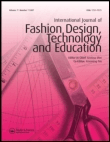
International Journal of Fashion Design Technology and Education
Exploring the Intersection of Design, Technology, and LearningThe International Journal of Fashion Design Technology and Education, published by Taylor & Francis Ltd, stands at the forefront of research in the dynamic fields of fashion design, technology, and education. Since its inception in 2008, the journal has provided a vital platform for researchers, educators, and practitioners to share innovative findings, pedagogical strategies, and technological advancements within the fashion industry. With an impressive impact factor and categorizations in the Q1 and Q2 quartiles across multiple disciplines—including Visual Arts, Education, and Industrial Engineering—this journal not only offers insightful contributions to academia but also informs practical applications in the ever-evolving fashion landscape. Although currently non-open access, the journal remains accessible to a wide range of audiences, facilitating a deeper engagement with contemporary issues in fashion technology and education. As the journal converges its themes through to 2024, it continues to encourage submissions that push the boundaries of knowledge and creativity, making it an essential resource for anyone invested in the future of fashion.
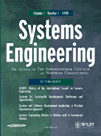
Systems Engineering
Navigating the Complexities of Modern SystemsSystems Engineering, published by WILEY, stands as a leading journal in the realms of Computer Networks and Communications and Hardware and Architecture, holding a Q2 quartile ranking in the former and a Q3 in the latter as of 2023. With its ISSN of 1098-1241 and E-ISSN 1520-6858, this journal has provided a vital platform for peer-reviewed research since its inception in 1998. Aimed at fostering knowledge and innovation, Systems Engineering caters to researchers, professionals, and students who are keen to explore the complexities and developments in systems design and optimization. The journal’s rigorous standards and strategic position in Scopus rankings—#148 in Computer Networks and Communications and #67 in Hardware and Architecture—underscore its significance and impact within the academic community. While currently not offering Open Access options, the journal remains committed to disseminating pioneering research that contributes to advancing the field.

ICONARP International Journal of Architecture and Planning
Elevating discourse on modern urban living and design.ICONARP International Journal of Architecture and Planning is an esteemed open-access publication that serves as a pivotal platform for fostering innovative research and discussions in the fields of architecture and urban design. Published by KONYA TECHNICAL UNIVERSITY, FACULTY OF ARCHITECTURE & DESIGN, this journal has been committed to the dissemination of high-quality academic work since 2013, promoting accessibility and global collaboration among researchers, professionals, and students. With its rigorous peer-review process and a focus on contemporary architectural and planning challenges, ICONARP seeks to contribute significantly to scholarly discourse and practical applications within the built environment. The journal is indexed in various scientific databases, enhancing its visibility and impact in the academic community. By appealing to a diverse audience, ICONARP encourages interdisciplinary studies and innovative solutions that address the complexities of modern architecture and urban living.
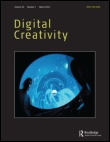
DIGITAL CREATIVITY
Exploring the Nexus of Technology and ArtistryDIGITAL CREATIVITY, published by Routledge Journals, Taylor & Francis Ltd, is a distinguished academic journal that serves as a vital platform for interdisciplinary research across the realms of Arts and Humanities, Computational Theory and Mathematics, Computer Graphics, and Human-Computer Interaction. Since its inception in 2005, this journal has aimed to explore the intersection of digital technologies and creative practices, making significant contributions to our understanding of digital aesthetics, interactive design, and the evolving nature of creativity in the digital age. With an impressive Q1 ranking in Arts and Humanities and notable standings in related computational fields, DIGITAL CREATIVITY appeals to a diverse audience of researchers, professionals, and students eager to engage with pioneering studies and innovative methodologies. While it presents valuable content primarily through subscription access, its credence in driving forward-thinking discussions is underscored by its ongoing relevance and commitment to advancing knowledge in a rapidly changing digital landscape. Join the conversation and contribute to shaping the future of digital creativity.

International Journal of Design
Exploring the Frontiers of Design InnovationThe International Journal of Design, published by National Taiwan University of Science and Technology, is a premier open-access journal that has been contributing to the field since 2007. With an ISSN of 1991-3761 and E-ISSN of 1994-036X, this journal focuses on the interdisciplinary nature of design and its applications across various domains including Computer Graphics, Industrial and Manufacturing Engineering, as well as Visual Arts. The journal has consistently achieved high rankings, including being placed in the top quartile (Q1) for several categories in 2023, reflecting its significance in academia and its impact on contemporary design research. Offering wide-ranging access options, the International Journal of Design serves as a valuable resource for researchers, professionals, and students looking to explore innovative design practices and theories. With its scope spanning both artistic and industrial applications, this journal is dedicated to fostering advancements in design and providing a platform for scholarly discussions that bridge the gap between theory and practice.

Architect
Bridging Theory and Practice in ArchitectureArchitect is a publication dedicated to the diverse and evolving field of architecture and design, presented by the reputable HANLEY WOOD, LLC. Since its inception in 1975, the journal has traversed critical periods in architecture, offering valuable insights and research that cater to both practitioners and academics alike. The journal holds a Q4 ranking in both Architecture and Visual Arts and Performing Arts, indicating its niche presence within the crowded scholarly landscape. Despite its recent rankings within the Scopus, where it lies in the lower percentiles of the architecture category, the Architect journal provides platforms for innovative discussions and explorations in design, helping to shape the discourse in the architectural community. While the journal is currently accessible via traditional subscription models, it remains a critical resource for those seeking to bridge practice and theory in architecture. As it continues to evolve beyond its historical publication periods, Architect aims to nurture a rich environment for professional growth, scholarship, and dialogue among researchers, designers, and students engaged in the dynamic world of architecture.